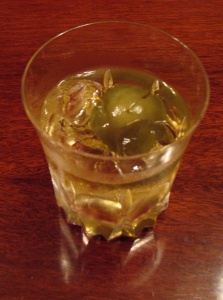 Rabbits of the internet, hear me! I’m taking this day outside of my usual Tuesday salad schedule to inform you of the start of something amazing, something magical, something wondrous. For now is the time of the ume, the small, sour, nasty little green plum that is good for two things: umeboshi and umeshu, and only the latter of the two tastes any good.
Rabbits of the internet, hear me! I’m taking this day outside of my usual Tuesday salad schedule to inform you of the start of something amazing, something magical, something wondrous. For now is the time of the ume, the small, sour, nasty little green plum that is good for two things: umeboshi and umeshu, and only the latter of the two tastes any good.
Umeshu is a Japanese liqueur made from the ume plum native to China. The fruit itself tastes like sour ass, but umeshu is pure fucking ambrosia. With an alcohol content of between 15-25% it’s sweet, slightly sour, sweet again and oh, so deliciously smooth. It can be drunk on the rocks, with soda, with tonic, or just mixed in with other, nastier liquors. It doesn’t matter, umeshu is awesome, and it’ll take one for the team to make sure your drinking experience tastes like a unicorn shat fruity, alcoholic rainbows in your mouth.
And The Partner and I are making it this year.
Umeshu is ridiculously easy to make. All you need is unripened green plums, rock sugar, shuchu and time. Lots of time. But if you’ve got all that, then by god, you can have yourself your own jug of umeshu to call your own.
Now, The Partner doesn’t drink, but she agreed to go along for the ride with me as we document our incredibly long, six month journey from this:
to this:
To start with, we needed our three tangible ingredients and a large jug to hold it all in. Fortunately, making umeshu is something of a house wives’ annual hobby. Or so I’m told. The tradition of the matron of the household making umeshu is slowly dying with the easy availability of factory made umeshu on the shelves of every supermarket and convenience store, but some women still stick to making it from scratch. As such, around this time of year, supermarkets stock their shelves with everything you need to make it, for a more or less affordable price.
The first step is to wash the jug. To prevent the umeshu from spoiling the jug needs to be completely sanitized before anything goes into it. This involves pouring boiling water into the jug, draining it and then letting it air dry. Once dry, the inside of the jug then needs to be wiped down with some of the shochu for good measure.
While waiting for the jug to dry, the ume plums need to be washed. Because they’re unripe, they are quite firm, making washing them rather easy. The Partner and I were following these directions, and while we were washing the plums, we got into an argument over what ‘hulling’ means. The directions say to “remove the hulls with a toothpick” so initially we thought this mean to pull out the little pieces of stem that still remained in the plums. Then we noticed that the directions that came in the bottle show a picture of a woman pricking the side of the plum with a toothpick.
After several minutes of debate we finally decided that it couldn’t hurt anything to do both. I handed The Partner a fun novelty toothpick and said, “here, stab it with pudding.” …You had to have been there.
After the plums were all washed and dried, it was time to put them in the jar. Because fresh fruit floats and sugar sinks in alcohol, the plums need to be layered in the rock sugar. So, we layered it all up and then poured in our shochu.
At first it seemed like it might not be enough to cover all the ingredients. I told The Partner that she might need to take a run to Liquor Mountain, which is a real, honest to god liquor store chain in Japan. Fortunately the 1.8 liter carton was more than enough, and we sealed up our jug and put it in the closet.
Now here we reach another point of contention. The website says to gently move the container every couple of days (presumably because the sugar and the plums immediately separated after 20 minutes of being immersed in the shochu. So much for layering.) However the directions on the bottle quite clearly state not to move it all. Yet another piece of advice given to us by a friend says that the mixture should be stirred every couple of days. So honestly, I’m not sure how to proceed at the moment. I sort of nudge it a little every morning. Hopefully that’s enough to satisfy all the recommendations.
Another bit of contrary advice is the length of time this mixture needs to sit. Some places say that it can be sampled in as little time as 3 months. Others suggest it is best to wait for a full year. Six months seems to be the only commonality these recommendations share, either as a maximum or a minimum, so I think that’s what we’ll go with.
Check back here for weekly or monthly updates as to the state of our liquor-making endeavor. Hopefully the thing doesn’t explode in our closet over the course of the next six months.










